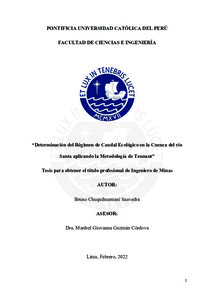| dc.contributor.advisor | Guzmán Córdova, Maribel Giovana | |
| dc.contributor.author | Chuquihuamani Saavedra, Bruno | |
| dc.date.accessioned | 2022-04-19T04:23:27Z | |
| dc.date.available | 2022-04-19T04:23:27Z | |
| dc.date.created | 2022 | |
| dc.date.issued | 2022-04-18 | |
| dc.identifier.uri | http://hdl.handle.net/20.500.12404/22143 | |
| dc.description.abstract | Es inevitable mencionar que el desarrollo del ser humano ha venido de la mano de la
explotación de los recursos naturales que el planeta provee; sin embargo, el uso desmedido
e indiscriminado de estos conllevará eventualmente a un desequilibrio ecológico que se
traducirá en la escasez de elementos que satisfagan las necesidades básicas que hoy en
día la población mundial necesita.
La minería, considerada como la veta dorada del desarrollo económico del Perú de los
últimos años, ha traído no solo progreso a las comunidades y poblaciones más alejadas y
afectadas por el abandono del Estado; sino también, ha llamado a una reflexión de cómo se
puede disminuir la contaminación y manejar el recurso hidrológico de una manera
responsable y adecuada.
En ese sentido el presente trabajo propone sentar las bases de futuros estudios que buscan
determinar la relación que existe entre la actividad minera y el impacto que tiene en el
consumo del caudal de ríos próximos y cercanos a la operación minera. El indicador que nos
permitirá medir esta relación será el Caudal Ecológico (también conocido como Caudal
Ambiental). Esta tesis abordará el análisis, evaluación y aplicación del método Tennant para
determinar el Caudal Ecológico del río Santa, el cual se ha afectado por muchos años por la
actividad minera.
La presente investigación propone trabajar con métodos hidrológicos, los cuales poseen
como principal dato de entrada a los registros de mediciones de caudales diarias, semanales,
mensuales o anuales. En este caso, el río Santa que forma parte de la cuenca del Pacífico,
de la región hidrográfica del Pacífico en la región de Áncash, Perú; posee una predominante
zona de actividad minera y es por ello considerada como adecuada para realizar el estudio
en mención.
Posteriormente, con la metodología definida, y los datos de campo validados, se podrá
analizar los resultados obtenidos para definir y evaluar el impacto de la minería en el caudal
ecológico del Rio Santa; donde se corroborará que esta industria no exige un consumo
masivo del recurso hídrico ni pone en peligro la continuidad del ecosistema propio de la
cuenca estudiada. | es_ES |
| dc.description.abstract | It is inevitable to mention that the development of human activity has gone along with the
exploitation of the natural resources that the planet supplies; nevertheless, the excessive and
non-discriminate use of these will eventually cause an ecological imbalance that will translate
into a shortage of elements that will meet the basic needs that the world population needs in
nowadays.
Mining, considered the jewel in the crown of Peru´s long-term economic development, has
not only contributed to the progress of the most distant communities and settlements affected
by the abandonment of the government, but has also prompted reflection on how to reduce
the contamination and manage hydrological resources in a more responsible and appropriate
manner.
In this respect, the purpose of this work is to set the basis for future investigations that will
seek to determinate the relationship between mining activity and the impacts it has on the
consumption of the flow of the rivers near and close to the mine operations. The parameter
that will enable us to gauge this relationship will be Ecological Flow (also known as
Environmental Flow). This thesis will address the analysis, assessment, and implementation
of the Tennant method to determinate the Ecological Flow of the Santa River, which for many
years has been affected by mining activity.
This research aims to work with hydrological methods, which have as the main input data the
registers of daily, weekly, monthly or annual flow measurements. In this instance, the Santa
River, which is part of the Pacific basin of the Pacific hydrographic region in the Ancash region
of Peru, has a predominantly mining area and is therefore considered appropriate for
conducting the mentioned study.
Subsequently, with the defined methodologies and the validated field data, it will be possible
to evaluate the results and define the impact of mining on the Ecological Flow of Santa River,
where it will be confirmed that this industry does not demand a large-scale consumption of
water resources and does not jeopardize the survival of the ecosystem of the basin being
studied. | es_ES |
| dc.language.iso | spa | es_ES |
| dc.publisher | Pontificia Universidad Católica del Perú | es_ES |
| dc.rights | info:eu-repo/semantics/openAccess | es_ES |
| dc.rights.uri | http://creativecommons.org/licenses/by-sa/2.5/pe/ | * |
| dc.subject | Recursos hídricos--Impacto ambiental--Perú | es_ES |
| dc.subject | Industria minera--Aspectos ambientales--Perú | es_ES |
| dc.subject | Ecohidrología--Perú | es_ES |
| dc.title | Determinación del Régimen de Caudal Ecológico en la Cuenca del río Santa aplicando la Metodología de Tennant | es_ES |
| dc.type | info:eu-repo/semantics/bachelorThesis | es_ES |
| thesis.degree.name | Ingeniero de Minas | es_ES |
| thesis.degree.level | Título Profesional | es_ES |
| thesis.degree.grantor | Pontificia Universidad Católica del Perú. Facultad de Ciencias e Ingeniería | es_ES |
| thesis.degree.discipline | Ingeniería de Minas | es_ES |
| renati.advisor.dni | 08681397 | |
| renati.advisor.orcid | https://orcid.org/0000-0002-7954-7679 | es_ES |
| renati.author.dni | 71927618 | |
| renati.discipline | 724026 | es_ES |
| renati.juror | Aduvire Pataca, Ernesto Osvaldo | es_ES |
| renati.juror | Guzman Cordova, Maribel Giovana | es_ES |
| renati.juror | Delgado Villanueva, Kiko Alexi | es_ES |
| renati.level | https://purl.org/pe-repo/renati/level#tituloProfesional | es_ES |
| renati.type | https://purl.org/pe-repo/renati/type#tesis | es_ES |
| dc.date.EmbargoEnd | 2022-12-01 | |
| dc.publisher.country | PE | es_ES |
| dc.subject.ocde | https://purl.org/pe-repo/ocde/ford#2.07.05 | es_ES |






